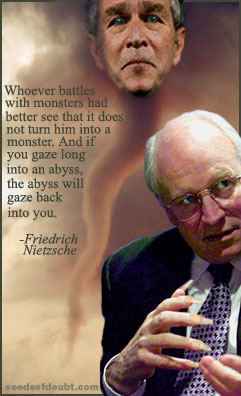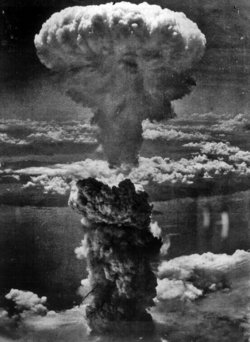| by Maureen Farrell "Recent pronouncements from the Bush Administration and national security initiatives put in place in the Reagan era could see internment camps and martial law in the United States." In 1984, the Rex-84 readiness exercise program was conducted by 34 federal departments and agencies, reportedly as an exercise to handle an influx of illegal aliens crossing the Mexican/U.S. border. Brought to Americans' attention during the Iran-contra hearings, the exercise, which was conducted alongside another drill, "Night Train 84," also tested military readiness to round up and detain citizens in case of massive civil unrest. None of that ever happened, of course, and in many respects, it seems silly to even mention it. After all, other Reagan-era initiatives, like the Armageddon exercises Dick Cheney and Donald Rumsfeld participated in, are far more interesting. Then, too, despite a brief moment of sunlight in the 1970s (when Congress, according to former President and CIA director George H.W. Bush, "unleashed a bunch of untutored little jerks out there"), emergency detention plans had been in place since the 1950s, without incident. Americans have not been herded into camps since World War II, so why worry about it now? For some, the answer comes in the form of yet another government contract awarded to Halliburton subsidiary, Kellogg, Brown & Root to build "temporary detention facilities" in case of an "immigration emergency." Reminiscent of Rex 84, which was conducted on the premise of preparing for "an influx of immigrants," there is reason to believe that hoards of poor, tired immigrants are not the true concern. As Tom Hennessy of the Press-Telegram recently pointed out, "there already are thousands of beds in place at various U.S. locations for the purpose of housing illegal immigrants." So what else might these centers be used for? Given predictions that another terror attack is all but certain, it seems far more likely that the centers would be used for post-911-type detentions of immigrants rather than a sudden deluge. "Almost certainly this is preparation for a roundup after the next 9/11 for Mid-Easterners, Muslims and possibly dissenters," Daniel Ellsberg remarked. "They've already done this on a smaller scale, with the 'special registration' detentions of immigrant men from Muslim countries, and with Guantanamo." As it turns out, immigrants aren't the only concern. As a news brief in the Atlanta Journal-Constitution explains:
Hurricane Katrina gave Americans a glimpse of how a natural disaster scenario might play out. John Brinkerhoff, one of the FEMA officials behind the Reagan-era martial law and internment directives who "planned for the detention of at least 21 million American Negroes in assembly centers or relocation camps" began defending the Pentagon's desire to deploy troops on American streets in 2002, and sure enough, after Hurricane Katrina, Blackwater mercenaries were brought in to police the streets of New Orleans -- as soldiers were instructed to "shoot to kill" looters. Brinkerhoff also told PBS that, "The United States itself is now for the first time since the War of 1812 a theater of war. That means that we should apply, in my view, the same kind of command structure in the United States that we apply in other theaters of war." Which brings us to the KBR spokesman's final statement regarding "new programs that require additional detention space." What might these new programs be? Do they have anything to do with the post-9/11 suggestions for forced quarantines or internment camps? Will America's new "secret laws" come into play? Might these "new programs" have anything to do with the contingencies Oliver North prepared for? Inquiring minds want to know. In 1987, the Miami Herald gave us a glimpse of what the lead counsel for the Senate Iran-contra committee called a "secret government-within-a-government" and alerted readers to standby legislation, which, as columnist Jack Anderson had previously warned, was meant to "suspend the Constitution and the Bill of Rights." Even so, when a memo from the Director of Resource Management for the Department of the Army emerged, discussing "civilian inmate labor camps" to be built on Army installations, only conspiracy buffs on the far fringes of the Internet paid it any mind. In 1998, World Net Daily's Geoff Metcalf addressed such "classic right wing paranoia," trying not to sound paranoid himself. "For several years now I have been getting all sorts of wild reports about 'Government Internment Camps,' he wrote, before disclosing two reasons he began sensing substance behind the rumors: 1) The labor camp memo was authentic, he said and 2) A U.S. congressman substantiated such claims. "The truth is yes -- you do have these standby provisions, and the plans are here ... whereby you could, in the name of stopping terrorism .. evoke the military and arrest Americans and put them in detention camps," Rep. Henry Gonzalez said in an interview. "Heck, we did it before (to Americans of Japanese descent), we could do it again," Metcalf mused. In the wake of the Sept. 11 attacks, it seemed that yes, we could do it again. When the Boston Herald reported on the Model State Emergency Health Powers Act sent to each state, it sounded sensationally surreal. "Public health officials want to shut down roads and airports, herd people into sports stadiums and, if needed, quarantine entire cities in the event of a smallpox attack, according to a plan being forwarded to all 50 governors this week," the Herald reported in Nov. 2001. By the summer of 2002, Peter Kirsanow, a Bush appointee to the U.S. Civil Rights Commission, said that a second terror attack would lead to internment camps for Arab-Americans while the Sydney Morning Herald reported that we "could see internment camps and martial law in the United States." The biggest bombshell, however, came from Attorney General John Ashcroft, whose proposal to send US citizens to detention camps, without the benefit of trial, jury or other Constitutional protections, was dissected by the Los Angeles Times. "The camp plan was forged at an optimistic time for Ashcroft's small inner circle, which has been carefully watching two test cases to see whether this vision could become a reality," the Times reported in August, 2002. "The cases of Jose Padilla and Yaser Esam Hamdi will determine whether U.S. citizens can be held without charges and subject to the arbitrary and unchecked authority of the government." Padilla was held without charges for more than three years, and when charges were finally filed against him, the chilling "dirty bomb" allegations made by Ashcroft on national TV were not even mentioned. His attorneys have vowed to take the case to the Supreme Court -- which is expected to side with presidential decrees. By the fall of 2005, news that the US could continue to "confine US citizens without charges," prompted conservative blogger Andrew Sullivan to dig up the following quote: "The power of the Executive to cast a man into prison without formulating any charge known to the law, and particularly to deny him the judgment of his peers, is in the highest degree odious and is the foundation of all totalitarian government whether Nazi or Communist" -- Winston Churchill, November 21, 1943, describing what is now legal and constitutional in the United States, under president Bush." Churchill, one supposes, did not include President Franklin Roosevelt in his condemnation, but when Ashcroft's plans for detention camps came to light, legal analysts began comparing the Bush administration's scheme to internment of Japanese Americans. "The main distinction is that Ashcroft's camps are smaller in scale. The difference in magnitude should not make the internment of U.S. citizens any more just or palatable," columnist Anita Ramasastry explained. And as Harvard Law Professor Lawrence Tribe said on ABC's Nightline:
Nevertheless, concerns over detention camps go hand-in-hand with jokes about black helicopters, and rightly so. The Internet is rife with rumors on everything from the more than "800 detention camps" already in existence to stories about Hurricane Katrina evacuees begin locked behind barbed wire in a concentration camp in Utah, which it turns out, was actually Camp Williams, an Army National Guard training center. When Diane Carmen of the Denver Post reported on evacuees at the Community College of Aurora, she wrote, "If I didn't know better, I'd have thought I was peering through the fence at a concentration camp," which some cited as "proof" that Americans were going to be rounded up and locked away, though the rest of the article did not substantiate such claims. "Everybody treats you real nice," said one evacuee. "There's a lotta love up here." The idea that dissidents could be sent to detention facilities is perhaps the most widely circulated theory, and it is as popular under President George W. Bush as it was under President Bill Clinton. And though Daniel Ellsberg has also suggested that dissidents could be targeted, most of the theories rest upon circumstantial evidence and long stretches of the imagination. What we do know, however, thanks to the Sydney Morning Herald's investigation into Reagan-era initiatives, alongside documents leaked to the Miami Herald in 1987, is that when Col. Oliver North helped draft contingency plans in the early 80s, one of the reasons cited for possible martial law and internment was "national opposition to a U.S. military invasion abroad" -- a scenario which would become more likely with additional wars and in the event of the return of the draft. Last year, the Project for a New American Century, the think tank that famously advocated preemptive strikes and wars on multiple fronts, called upon Congress to "take the steps necessary to increase substantially the size of the active duty Army and Marine Corps." Such steps should be relatively easy, given that since PNAC's "Rebuilding America's Defenses" was first published, states have been linking driver's license applications to selective service registration. According to the Selective Service System's Web site, "As of August 5, 2005, 35 states, 3 territories, and the District of Columbia have enacted driver's license laws supporting SSS registration." With the military stretched to the breaking point, questions of conscription and subsequent draft-dodging are hardly far-fetched, but the very act of protesting, in and of itself, could become a federal offense. Though conservative columnist William Safire was one of the first to warn of Mr. Bush's "dictatorial powers," and editorials across the country have since voiced similar concerns, few are picking up on attempts to criminalize dissent -- an observation made by former White House counsel John Dean as early as Oct. 2001, who wrote that, thanks to the hastily passed Patriot Act, the "right to dissent" is in jeopardy, with protesters possibly considered "terrorists." Dean considered this an "unintended consequence" of the new anti-terror legislation, but the Oakland Tribune later reported that California's anti-terrorism intelligence center was already "blurring the line between terrorism and political dissent" and National Lawyers Guild president Michael Avery said that the Bush administration was "trying to criminalize dissent, characterize protesters as terrorists and trying to intimidate and marginalize those opposed to its policies." After a New York state jury refused to convict four Catholic antiwar activists for protesting at a U.S. military recruiting office in 2005, the federal government stepped in, filing charges including "conspiracy to impede an officer of the United States," which could send each protester to prison for up six years. Is this an isolated incident? It would seem not. Provisions in the new Patriot Act have also raised concerns. The first questionable provision could make "breaching security perimeters" at any "special event of national significance" a felony while the second calls for the creation of a new federalized "permanent police force" which would be given the authority to arrest citizens in violation of the Bill of Rights. "The obvious purpose of the act is to prevent demonstrations at Bush/Cheney events," former Reagan administration official Paul Craig Roberts recently wrote, adding that the law has "dire implications" for First Amendment guarantees. "We can take for granted that the new federal police will be used to suppress dissent and to break up opposition. The Brownshirts are now arming themselves with a Gestapo." Even before Sept. 11, a document entitled "Domestic Operational Law Handbook for Judge Advocates," reflected a movement towards a more militarized society. The JAG document, which called for "providing military assistance for civil disturbances" cited the '60s era Operation Garden Plot, the United States Civil Disturbance Plan 55-2, which gave federal forces the power to "put down" "disruptive elements" and called for "deadly force to be used against any extremist or dissident perpetrating any and all forms of civil disorder." As Frank Morales stated in an update to his 2003 Project Censored award-winning story "The Pentagon Wages War on America":
It should be noted that the government has traditionally tried to curb dissent during wartime and much of what we're seeing today existed in the Vietnam era, too. In 1967, with the assistance of an Army task force, President Lyndon Johnson established the National Advisory Commission on Civil Disorders, which called for the use of military force to squelch civil disturbances. A year after four unarmed Kent State University students were gunned down by members of the Ohio National Guard, Sen. Sam Ervin's Subcommittee on Constitutional Rights uncovered information regarding Operation Garden Plot and discovered a massive military surveillance program used against citizens. The FBI's domestic counterintelligence program, COINTELPRO also came to light when the Citizens Committee to Investigate the FBI lifted documents and leaked them to the press. And, as we later learned, from 1967 to 1971 the FBI also kept an "agitator index" or ADEX file, which was a list of individuals to be rounded up as subversives. Operation Cable Splicer, a subplot of Operation Garden Plot which included plans to control civilian populations and take over state and local governments, also appeared to be in play during Hurricane Katrina, when President Bush announced that the Pentagon was developing plans to give the military a larger role in responding to catastrophic events and suggested that the federal government should override state and local authorities. "It is now clear that a challenge on this scale requires greater federal authority and a broader role for the armed forces," Bush said in a speech. (The president also announced that the U.S. military could enforce quarantines should there be a bird flu outbreak, which Irwin Redlener, associate Dean of Columbia University's School of Public Health for Disaster Preparedness, deemed an "extraordinarily draconian measure," which translates to "martial law in the United States."). In 2002, a New York Times editorial stated that the FBI now has "nearly unbridled power to poke into the affairs of anyone in the United States, even when there is no evidence of illegal activity" and one year later, FBI Intelligence Bulletin no. 89 was sent to police departments, revealing that the federal government was advocating that local authorities spy on U.S. citizens. When the Atlanta Police Department acknowledged that it routinely places antiwar protesters under surveillance, Georgia Rep. Nan Orrock told the Atlanta Journal-Constitution. "This harkens back to some very dark times in our nation's history." Where will all this data mining lead? Who knows? From Sedition Acts, to the suspension of habeas corpus to the internment of fellow Americans, we've been down rocky roads before. And in the aftermath of Sept. 11, Supreme Court Justice Sandra Day O'Conner spelled it out: "We're likely to experience more restrictions on our personal freedom than has ever been the case in our country," she said. Now that writing letters to the editor can be investigated as acts of "sedition" and US citizens can be held without charges for years on end, another terror attack could send us over the edge. Even so, detention camp jitters could prove to be nothing more than Waitsian. After all, Kellogg Brown & Root held US Immigration and Customs Enforcement (ICE) contracts from 2000 to 2005 without building a single camp. The truth is, we won't know the real purpose of these centers unless contingency plans are needed. And by then, it will be too late. | ||
|
|
Monday, February 13, 2006
Maureen Farrell: Detention Camp Jitters
Subscribe to:
Post Comments (Atom)







No comments:
Post a Comment